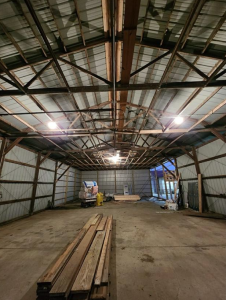Coming from a background in the prefabricated roof truss industry, knee braces have always bothered me.
What is a knee brace? I’m not talking about the type you wear for a dislocated or arthritic knee joint.
A knee brace is an inclined diagonal lumber member connecting to and extending from the sidewall columns, usually several feet below the truss to column connection, across and attached to the face of the trusses. They are intended to supplement the lateral resistance of post frames when loaded by lateral wind forces.
The intent of knee bracing is noble – to supplement the resistance of post frames (columns along with aligned roof trusses create a post frame) under lateral (wind) loads. They can influence the unsupported length of the columns. As the unsupported length of the column is reduced, it is less prone to buckle.
Pole building frames, prior to installation of roofing and siding, tend to be very flexible. It is the sheathing which makes the building stiff. It would not be unheard of to stand on top of the center of a framed up only building and be able to rock the building six to eight inches! Adding knee braces at this point of construction will stiffen the frame and act as a temporary brace.
 The effectiveness of a knee brace is highly dependent on the stiffness of the connections to the post and the truss. If the connections at the ends of the brace are flexible or not very stiff due to the use of a few nails, the roof diaphragm carries the bulk of the load and the brace is ineffective. If the brace connections are made very stiff (by installing many nails or bolts) the brace could effectively resist the wind loading, but overload the truss.
The effectiveness of a knee brace is highly dependent on the stiffness of the connections to the post and the truss. If the connections at the ends of the brace are flexible or not very stiff due to the use of a few nails, the roof diaphragm carries the bulk of the load and the brace is ineffective. If the brace connections are made very stiff (by installing many nails or bolts) the brace could effectively resist the wind loading, but overload the truss.
Knee braces induce bending moments in truss chords. If used in a post-frame design, load sharing among the truss, post, knee brace, connections and roof diaphragm must be included in the structural analysis.
Johnston and Curtis, in 1984, performed actual testing on post frame buildings with and without knee braces. They concluded, “As loads were increased, the effect of the knee bracing became insignificant.” The study found knee bracing in post frame buildings provides very little support for horizontal loads. Two years later, as a result of their studies, Gebremedian and Woeste concluded, “Knee braces added little stiffness to the post-frame building analyzed.
In a presentation to the International Conference of Timber Engineering in 1988, Jerry Barbera (at the time chief engineer for the Pacific Northwest office of the International Conference of Building Officials) stated, “When the knee brace is placed on the truss at random the truss will experience considerable stress.”. Further, he said, “Thus the truss designer has to know what the extraneous forces are in order to design for their effects. Both designers have to communicate with each other”.
Walker and Woeste’s 1992 book Post Frame Design states, “Knee braces appear to be a “no-win” solution.”
In all likelihood, pole buildings being proposed as utilizing knee braces are a result of lack of knowledge upon the part of those who are providing the building. The knee braces add no benefit to the overall strength of the structure, while potentially adding loads into the roof trusses, which they were not designed to carry. In the right combination of circumstances, this could result in a catastrophic failure of the building.






